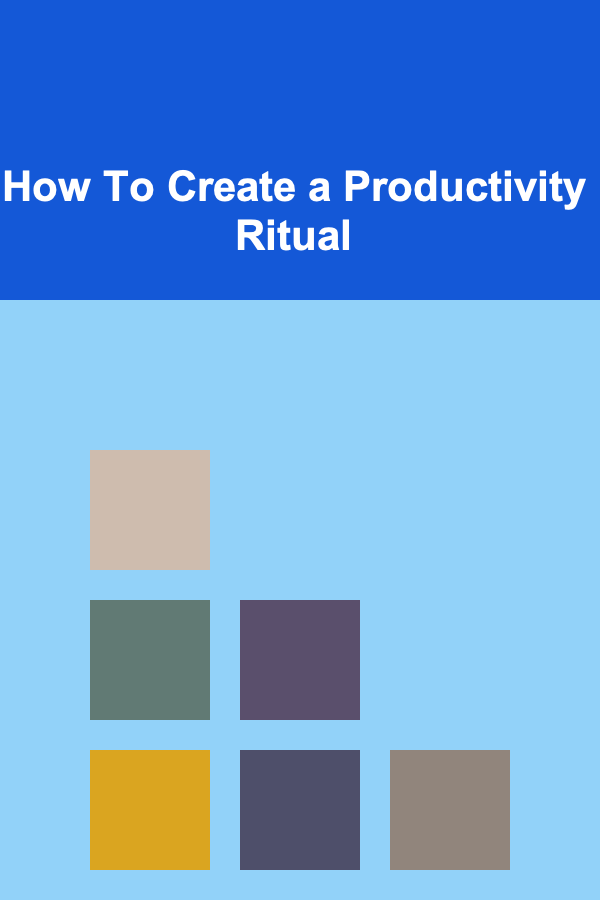
How To Create a Productivity Ritual
ebook include PDF & Audio bundle (Micro Guide)
$12.99$6.99
Limited Time Offer! Order within the next:

In today's fast-paced and demanding world, productivity is more than just a buzzword; it's a necessity for achieving our goals, maintaining our sanity, and leading fulfilling lives. While there are countless productivity hacks and techniques available, one of the most effective and sustainable strategies is establishing a productivity ritual. A productivity ritual is a set of intentional, consistent actions that you perform regularly, designed to prime your mind and body for focused work and optimal performance. It's about creating a dedicated space, both mentally and physically, for deep work and minimizing distractions. This article will delve into the concept of productivity rituals, exploring their benefits, providing a step-by-step guide to creating your own, and offering practical tips for maintaining and refining your ritual over time.
Understanding the Power of Rituals
Rituals are deeply ingrained in human behavior. Throughout history and across cultures, rituals have served as a way to mark important transitions, build community, and create a sense of meaning and purpose. From religious ceremonies to personal habits, rituals provide structure, predictability, and a sense of control in a world that often feels chaotic. A productivity ritual leverages these inherent psychological benefits to enhance focus, motivation, and overall work quality. Think of it as a deliberate programming of your subconscious mind to associate specific actions with a state of heightened productivity.
The key difference between a simple routine and a ritual lies in the intention and mindfulness behind the actions. A routine might be something you do mindlessly, like brushing your teeth. A ritual, on the other hand, involves conscious awareness and a sense of purpose. It's about deliberately creating the right mental and emotional state for productive work.
Here's why rituals are so powerful for boosting productivity:
- Reduced Decision Fatigue: By automating the initial steps of your workday, you eliminate the need to make countless small decisions, preserving your mental energy for more important tasks. "What should I do first?" becomes a non-question.
- Improved Focus and Concentration: A consistent ritual acts as a signal to your brain that it's time to focus. It helps you transition from a state of distraction to a state of deep work more easily.
- Enhanced Motivation and Energy: Rituals can trigger positive emotions and release endorphins, boosting your mood and energy levels, making you more enthusiastic about tackling your work. A well-designed ritual can feel empowering and motivating.
- Increased Consistency and Discipline: By making productivity a habitual practice, you're more likely to stick to your goals and avoid procrastination. The ritual acts as an anchor, pulling you back on track when you feel tempted to stray.
- Stress Reduction: The predictability and control provided by a ritual can help reduce stress and anxiety, creating a more calm and focused work environment. Knowing what to expect can be incredibly reassuring.
Step-by-Step Guide to Creating Your Productivity Ritual
Creating a successful productivity ritual is a personalized process. What works for one person may not work for another. The key is to experiment, iterate, and find a combination of actions that resonate with you and effectively prime you for focused work. Here's a step-by-step guide to help you get started:
Step 1: Define Your Productivity Goals
Before you start building your ritual, it's crucial to clearly define what productivity means to you. What specific outcomes are you hoping to achieve? Are you aiming to increase your output, improve the quality of your work, reduce stress, or simply feel more in control of your time? Your goals will inform the design of your ritual.
Consider these questions:
- What are your most important tasks and priorities?
- What obstacles typically hinder your productivity? (e.g., distractions, procrastination, lack of motivation)
- What does a successful workday look like for you?
For example, your goal might be to:
- Write 1000 words of your book chapter each morning.
- Complete all assigned tasks on your project management board by the end of the day.
- Respond to all urgent emails within the first hour of the workday.
Step 2: Identify Key Components
Once you have a clear understanding of your productivity goals, you can start brainstorming potential components for your ritual. These components should be actions that will help you overcome obstacles, boost your motivation, and create a focused and productive environment. Think about activities that make you feel energized, calm, and prepared to work.
Here are some common and effective components to consider:
- Mindfulness and Meditation: Even a few minutes of mindfulness meditation can significantly reduce stress, improve focus, and enhance self-awareness. Use apps like Headspace or Calm, or simply focus on your breath.
- Physical Activity: Exercise is a powerful way to boost energy levels, improve mood, and clear your head. Consider a brisk walk, a short yoga session, or even a few minutes of stretching.
- Hydration and Nutrition: Dehydration and hunger can significantly impact cognitive function and energy levels. Start your day with a glass of water and a healthy breakfast or snack. Avoid sugary drinks and processed foods.
- Reviewing Goals and Priorities: Taking a few minutes to review your goals and priorities can help you stay focused and motivated. Look at your to-do list, calendar, or project management board.
- Setting Intentions: Clearly stating your intentions for the day can help you stay on track and avoid distractions. Write down your intentions, or simply say them out loud. For example, "Today, I will focus on completing the alpha version of this software module."
- Creating a Dedicated Workspace: Having a clean, organized, and dedicated workspace is essential for minimizing distractions and promoting focus. Make sure your workspace is free of clutter and has everything you need to work efficiently.
- Limiting Distractions: Turn off notifications on your phone and computer, close unnecessary tabs, and let others know that you need uninterrupted time. Consider using website blockers or productivity apps to help you stay focused.
- Listening to Music or White Noise: Certain types of music or white noise can help improve focus and concentration. Experiment with different genres and sounds to find what works best for you.
- Reading: Reading, even for a few minutes, can be stimulating and inspiring. Choose material related to your field or something enjoyable.
- Journaling: Journaling can help you clear your mind, process your thoughts and emotions, and gain clarity on your goals. Write about your challenges, successes, or simply what you're grateful for.
- Gratitude Practice: Reflecting on things you are grateful for can boost your mood and create a more positive outlook. Write down three things you are grateful for each morning.
Step 3: Design Your Ritual Sequence
Once you have identified your key components, it's time to design the sequence of actions that will make up your ritual. The order of these actions is important. Think about how each component will build upon the previous one, creating a smooth and natural flow that prepares you for focused work.
Consider these factors when designing your sequence:
- Time of Day: Will your ritual be a morning ritual, an afternoon ritual, or both? Most people find that a morning ritual is the most effective, as it sets the tone for the entire day.
- Duration: How long will your ritual last? Start with a short ritual (e.g., 15-30 minutes) and gradually increase the duration as needed. It's better to have a short, consistent ritual than a long, sporadic one.
- Energy Levels: Start with activities that require less mental energy and gradually transition to more demanding tasks. For example, you might start with meditation, then move on to reviewing your goals, and finally begin working on your most important task.
Here are a few example ritual sequences:
Example 1 (Morning Ritual - 30 minutes):
- Wake up and drink a glass of water. (2 minutes)
- Mindfulness meditation (5 minutes)
- Light stretching (5 minutes)
- Review goals and priorities for the day (5 minutes)
- Set intentions (2 minutes)
- Prepare a healthy breakfast (11 minutes)
Example 2 (Afternoon Ritual - 15 minutes):
- Step away from your computer and take a short walk. (5 minutes)
- Listen to uplifting music. (5 minutes)
- Review progress on current tasks. (3 minutes)
- Plan the next hour of work. (2 minutes)
Step 4: Implement and Experiment
Once you have designed your ritual, it's time to put it into practice. Commit to following your ritual consistently for at least two weeks. This will give you enough time to see how it impacts your productivity and identify areas for improvement. Treat this initial phase as an experiment.
During this period, pay attention to the following:
- How do you feel during and after your ritual? Do you feel more focused, energized, and motivated?
- How does your productivity compare to your previous performance? Are you able to accomplish more in less time?
- What challenges do you encounter? Are there any aspects of your ritual that are difficult to maintain?
Keep a journal to track your progress and record your observations. This will help you identify what's working and what's not.
Step 5: Refine and Optimize
After two weeks of experimentation, you can start refining and optimizing your ritual. Based on your observations and feedback, make adjustments to the components, sequence, or duration of your ritual to make it more effective and sustainable.
Consider these questions:
- Are there any components that you can eliminate or replace?
- Are there any new components that you should add?
- Is the sequence of actions optimal?
- Is the duration of the ritual appropriate?
Don't be afraid to experiment and try different things. The key is to find a ritual that works best for you and that you can consistently maintain over time. This is an iterative process, and your ritual will likely evolve as your needs and goals change.
Tips for Maintaining Your Productivity Ritual
Creating a productivity ritual is only half the battle. The real challenge is maintaining it consistently over time. Here are some tips to help you stay on track:
- Make it a Priority: Treat your productivity ritual as an essential part of your workday, just like any other important meeting or task. Schedule it in your calendar and protect that time.
- Start Small: Don't try to do too much too soon. Start with a short, simple ritual and gradually increase the duration and complexity as you become more comfortable.
- Be Consistent: Consistency is key to building a strong habit. Try to follow your ritual at the same time and in the same place each day.
- Be Flexible: While consistency is important, it's also important to be flexible. Life happens, and sometimes you won't be able to follow your ritual exactly as planned. Don't let these occasional setbacks derail you. Simply get back on track as soon as possible.
- Track Your Progress: Tracking your progress can help you stay motivated and identify areas for improvement. Use a journal, spreadsheet, or productivity app to track your adherence to your ritual and your overall productivity levels.
- Find an Accountability Partner: Having someone to hold you accountable can significantly increase your chances of success. Find a friend, colleague, or coach who can help you stay on track.
- Reward Yourself: Reward yourself for consistently following your ritual. This can be a simple treat, like a cup of coffee or a short break, or something more significant, like a weekend getaway.
- Be Patient: It takes time to build a new habit. Don't get discouraged if you don't see results immediately. Just keep practicing your ritual consistently, and eventually it will become an automatic part of your daily routine.
- Reflect Regularly: Periodically review your ritual and assess its effectiveness. Are you still getting the benefits you intended? Are there any areas that need improvement? Make adjustments as needed to ensure your ritual remains relevant and effective.
Common Pitfalls to Avoid
While productivity rituals can be incredibly beneficial, it's important to be aware of common pitfalls that can derail your efforts:
- Making it Too Complicated: A complex ritual can be overwhelming and difficult to maintain. Keep it simple and focused on the most essential components.
- Being Too Rigid: While consistency is important, being too rigid can make it difficult to adapt to unexpected changes or circumstances. Be flexible and willing to adjust your ritual as needed.
- Focusing Too Much on the Ritual, Not the Work: The purpose of a productivity ritual is to prepare you for focused work, not to become an end in itself. Don't get so caught up in the ritual that you lose sight of your goals.
- Ignoring Your Body's Needs: Pay attention to your energy levels and physical well-being. If you're feeling tired or stressed, adjust your ritual accordingly.
- Comparing Yourself to Others: Everyone is different, and what works for one person may not work for another. Focus on creating a ritual that works best for you, rather than trying to imitate someone else.
- Neglecting Environment: The physical environment around you can greatly impact the effectiveness of your ritual. If your workspace is distracting or uncomfortable, address those issues.
Examples of Productivity Rituals in Different Fields
Productivity rituals aren't confined to specific professions. They can be tailored to fit any field or role. Here are some examples:
- Writer: Morning journaling, outlining the day's writing goals, reading inspiring material, brewing a cup of tea, and silencing notifications.
- Programmer: Reviewing code from the previous day, writing unit tests, setting a Pomodoro timer, and closing all non-essential applications.
- Entrepreneur: Reviewing key performance indicators (KPIs), responding to urgent emails, setting three priorities for the day, and engaging in a short visualization exercise.
- Student: Reviewing notes from the previous lecture, creating a study schedule, setting learning goals, and finding a quiet study space.
- Salesperson: Reviewing sales targets, practicing the sales pitch, researching potential clients, and making prospecting calls.
Conclusion
Creating a productivity ritual is a powerful strategy for enhancing focus, motivation, and overall work quality. By intentionally designing a set of consistent actions that prime your mind and body for productive work, you can overcome obstacles, reduce stress, and achieve your goals more effectively. Remember that the key to success is to experiment, iterate, and find a combination of components that resonate with you and that you can consistently maintain over time. Embrace the process of building your ritual as an ongoing journey of self-discovery and optimization. With dedication and patience, you can transform your daily routine into a powerful engine of productivity and fulfillment.

How to Use Technology to Document Your Time Capsule Contents
Read More
How to Master 3D Printing for Jewelry Making
Read More
How To Foster Curiosity and Exploration
Read More
How To Declutter Your Bathroom for Serenity
Read More
Understanding Blockchain Interoperability: Bridging the Silos of the Digital Ledger
Read More
How to Cross-Stitch Tiny, Detailed Patterns
Read MoreOther Products

How to Use Technology to Document Your Time Capsule Contents
Read More
How to Master 3D Printing for Jewelry Making
Read More
How To Foster Curiosity and Exploration
Read More
How To Declutter Your Bathroom for Serenity
Read More
Understanding Blockchain Interoperability: Bridging the Silos of the Digital Ledger
Read More